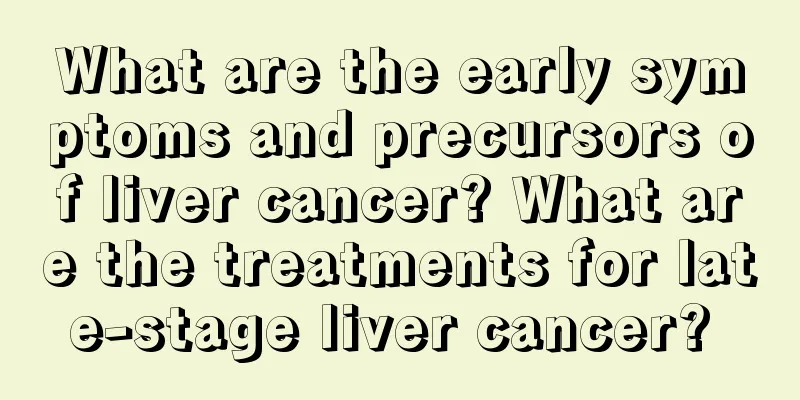What are the early symptoms and precursors of liver cancer? What are the treatments for late-stage liver cancer?

|
Liver cancer is the third most common malignant tumor with a mortality rate second only to gastric cancer and esophageal cancer. The early symptoms are not obvious, and the main manifestations in the late stage are liver pain, fatigue, weight loss, jaundice, ascites and other symptoms. Clinically, Western medicine surgery, radiotherapy, chemotherapy and traditional Chinese medicine are generally used in combination, but the cure rate for advanced patients is low due to the spread of cancer cells. Therefore, early detection, early diagnosis and early treatment of liver cancer are necessary. We should do a good job in liver cancer prevention and adhere to the seven-character liver cancer prevention policy of managing water, managing food and preventing hepatitis. Common symptoms: fatigue, liver pain, jaundice, weight loss, loss of appetite, formation of portosystemic collateral circulation, ascites, portosystemic collateral circulation, poor appetite, refractory ascites Liver pain, fatigue, poor appetite and weight loss are the most characteristic clinical symptoms. Early symptoms: The early symptoms of liver cancer are very atypical and are often easily overlooked. The following symptoms can be used as a reference: 1. Obvious loss of appetite: abdominal distension, indigestion, sometimes nausea and vomiting; 2. Dull pain in the right upper abdomen: There may be persistent or intermittent pain in the liver area, which may sometimes be aggravated by changes in body position; 3. Fatigue, weight loss, unexplained fever and edema; 4. Jaundice, ascites, and skin itching; 5. It often manifests as nose bleeding, subcutaneous bleeding, etc. Symptoms in the middle and late stages: Typical symptoms and signs of liver cancer generally appear in the middle and late stages, mainly including liver pain, fatigue, weight loss, jaundice, ascites, etc. 1. Pain in the liver area: The most common type is intermittent, persistent dull pain or bloating. The pain is caused by the rapid growth of the cancer, which tightens the liver capsule and causes the tumor to invade the diaphragm. The pain may radiate to the right shoulder or right back. The tumor growing to the right back may cause right waist pain. The sudden onset of severe abdominal pain and peritoneal irritation signs indicates bleeding under the capsule of the cancer nodule or rupture into the abdominal cavity. 2. Gastrointestinal symptoms: decreased appetite, indigestion, nausea, vomiting and diarrhea are easily overlooked due to their lack of specificity. 3. Fatigue, weight loss, and general weakness. A small number of patients may develop cachexia in the late stages. 4. Fever: Generally, the temperature is low and reaches above 39°C, which is continuous fever or low fever in the afternoon or high fever of remittent type. Fever is related to the absorption of necrotic products of tumor. Compression or invasion of bile duct by tumor may cause biliary infection. 5. Symptoms of metastatic lesions: There are corresponding symptoms at the place where the tumor metastasizes, which sometimes become the first symptoms of liver cancer. For example, metastasis to the lungs can cause coughing and hemoptysis; pleural metastasis can cause chest pain and bloody pleural effusion; embolism of the pulmonary artery or branches can cause pulmonary infarction, which can cause sudden severe dyspnea and chest pain; blockage of the inferior vena cava by the tumor thrombus can cause severe edema of the lower limbs and even a drop in blood pressure; blockage of the hepatic vein can cause Budd-Chiari syndrome and edema of the lower limbs; metastasis to the bones can cause local pain or pathological fractures; metastasis to the spine or compression of the spinal nerves can cause local pain and paraplegia; intracranial metastasis can cause corresponding localization symptoms and signs, such as intracranial hypertension, which can lead to brain herniation and sudden death. 6. Other systemic symptoms: Endocrine or metabolic syndromes caused by abnormal metabolism of the tumor itself or various effects of cancer tissue on the body are called paraneoplastic syndromes, which may sometimes precede the symptoms of liver cancer itself. Common ones include: ⑴ Spontaneous hypoglycemia: 10-30% of patients may experience this condition due to the ectopic secretion of insulin or insulin-like substances by liver cells, or the inhibition of insulinase by tumors, or the secretion of a pancreatic β-cell stimulating factor, or excessive glycogen storage; it may also be caused by excessive glucose consumption by liver cancer tissue. In severe cases, it may lead to coma, shock, and death. Correct judgment and timely symptomatic treatment can save patients from death. (2) Polycythemia: 2-10% of patients may experience related symptoms which may be caused by increased erythropoietin in the circulation. ⑶ Other rare diseases include hyperlipidemia, hypercalcemia, carcinoid syndrome, early sexual intercourse and gonadotropin secretion syndrome, cutaneous porphyria and dysfibrinogenemia, which may be related to abnormal protein synthesis, ectopic endocrine secretion and porphyrin metabolism disorders in liver cancer tissue. 7. Paraneoplastic syndrome: The abnormal metabolism of the tumor itself affects the body and causes endocrine or metabolic abnormalities, which is called paraneoplastic syndrome. Hypoglycemia and polycythemia are the most common, while other rare syndromes include hyperlipidemia, hypercalcemia, precocious puberty, gonadotropin secretion syndrome, carcinoid syndrome, etc. 8. Signs of liver cancer - jaundice. Jaundice is a common sign of advanced liver cancer. Diffuse liver cancer and cholangiocarcinoma are most likely to cause jaundice. Jaundice is mostly caused by compression of the bile duct or invasion of the bile duct by cancer, or compression of the bile duct by enlarged lymph nodes metastasized from the liver hilum. In a few cases, the liver cancer tissue grows into the bile duct, and the mass blocks the bile duct, causing obstructive jaundice. Viral hepatitis (50%): Epidemiological statistics show that areas where hepatitis B is prevalent are also high-risk areas for liver cancer. People who have had hepatitis B are 10 times more likely to develop liver cancer than those who have not had hepatitis B. Alcohol (35%): As the saying goes, "drinking alcohol hurts the liver." Drinking alcohol is not the direct cause of liver cancer, but it acts like a catalyst, which can promote the occurrence and progression of liver cancer. Diet-related factors (15%): The occurrence of liver cancer is closely related to lifestyle habits. Long-term consumption of moldy food, food containing nitrosamines, and lack of trace element selenium are also important factors that promote liver cancer. In general, the cause of primary liver cancer has not been fully elucidated so far, but it has been shown to be closely related to the following factors: 1. Viral hepatitis: Long-term clinical observations have shown that hepatitis, cirrhosis, and liver cancer are a three-step process that evolves continuously. Recent studies have shown that viral hepatitis associated with liver cancer mainly includes hepatitis B (HBV) and hepatitis C (BCV), among which hepatitis B is the most common. 2. Alcohol: Long-term alcoholism is prone to liver cancer. This is because after alcohol enters the human body, it is mainly decomposed and metabolized in the liver. The toxicity of alcohol to liver cells causes liver cells to have obstacles in the decomposition and metabolism of fatty acids, causing fat deposition in the liver and resulting in fatty liver. The more alcohol is consumed, the more severe the fatty liver becomes, which in turn causes liver fibrosis, cirrhosis, and liver cancer. If hepatitis patients drink heavily, it will greatly accelerate and aggravate the formation and development of cirrhosis and promote the occurrence of liver cancer. 3. Diet-related factors: Aflatoxin B1 is a substance that has been proven to have a clear carcinogenic effect. It is mainly found in moldy food, such as corn, peanuts, rice, etc. In addition, when a large amount of food containing nitrite is consumed, nitrite accumulates in the body and cannot be discharged in time, and can be converted into nitrosamines in the body. Foods with high nitrite content are smoked or salted meat products, which have a clear carcinogenic effect. At the same time, the occurrence of liver cancer is also related to genetic factors, parasitic infections and other factors. Daily prevention: 1Avoid emotional fluctuations, maintain an optimistic mental state, and try to avoid or reduce various stimulating activities that cause emotional fluctuations; 2. Avoid overwork: Excessive mental or physical labor can not only reduce the body's resistance of liver cancer patients, causing cancer recurrence or metastasis, but also aggravate liver damage and lead to worsening of the disease; 3. Get rid of bad lifestyles or habits: avoid smoking and drinking, do not eat moldy food, eat less pickled meat products, etc.; 4. Regular life, daily living, outdoor activities, diet and nutrition, physical exercise; 5. Avoid infection with hepatitis B and hepatitis C. The prevention and treatment of liver cancer is a long and arduous task. Professional guidance: 1. Patients with a history of liver diseases such as hepatitis B and hepatitis C should have their blood AFP levels and liver B-ultrasound checked regularly to achieve early detection, diagnosis and treatment of liver cancer. 2. For patients who develop liver cancer on the basis of hepatitis, attention should be paid to the importance of antiviral treatment. Early antiviral treatment can effectively control the progression of liver cancer. 3. Once liver cancer is diagnosed, a reasonable individualized treatment plan for liver cancer should be selected based on the size and location of the tumor, the presence or absence of intrahepatic and extrahepatic metastasis, and the patient's general condition. Currently, surgical resection is still the most effective means of treating liver cancer. Multimodal comprehensive treatment and multidisciplinary team joint diagnosis and treatment can significantly improve the patient's prognosis. 4. Liver transplantation is an effective means of curing liver cancer, especially for patients with small hepatocellular carcinoma who have cirrhosis and liver decompensation. However, its indications should be strictly controlled for advanced liver cancer. 5. Regular follow-up after liver cancer surgery is very important. Imaging examinations and dynamic monitoring of AFP changes should be performed regularly. Surgical resection: not suitable for patients with liver cirrhosis. Drug injection Local heating Low temperature freezing: For example: percutaneous alcohol injection therapy, etc. High frequency cauterization Transcatheter arterial embolization Targeted drug therapy + guided spiral knife 1. Balanced diet: Liver cancer patients consume a lot of energy, so they must be guaranteed to have enough nutrition. The simplest way to measure the nutritional status of patients is whether they can maintain their weight. To maintain a normal weight, the best way is to maintain a balanced diet, requiring patients to eat more fresh vegetables, and half of them should be green leafy vegetables. 2. Fat and protein: A high-fat diet can affect and aggravate the condition, while a low-fat diet can alleviate symptoms such as nausea, vomiting, and abdominal distension in liver cancer patients. Liver cancer patients have poor appetite and eat less. If they do not have a balanced diet, they must increase the calories of their diet and eat crude fat that is easy to digest and absorb. Liver cancer patients should eat more foods rich in plant protein, especially high-quality plant protein. 3. Vitamins: Vitamins A, C, E, K, etc. have certain auxiliary anti-tumor effects. Vitamin C is mainly found in fresh vegetables and fruits. Carotene can be converted into vitamin A after entering the human body, so liver cancer patients should eat more vegetables and fruits rich in vitamin C. 4. Inorganic salts: minerals. Nutritionists divide inorganic salts into two categories: macroelements, such as calcium, sodium, potassium, etc.; trace elements, such as selenium, zinc, iodine, etc. Scientists have found that minerals such as selenium and iron have anti-cancer effects. 5. Liver cancer patients often have symptoms of indigestion such as loss of appetite, nausea, and abdominal distension, so they should eat easily digestible food. 6. Most patients with advanced liver cancer are in a state of systemic failure and have difficulty eating. They should focus on strengthening their body and eat easily digestible foods. 1. Avoid tobacco, alcohol, spicy food and fried food; 2. Avoid eating moldy food; 3. Avoid eating foods that enhance immune function. |
Recommend
Drugs for treating advanced kidney cancer
Kidney cancer is a common malignant tumor. In rec...
What is the standard staging of gallbladder cancer
In recent years, gallbladder cancer has become on...
Functional intestinal disorders
Functional intestinal disorder is a chronic disea...
What is the reason for having too much fat on the belly?
Many people have fat on their stomachs, whether t...
Yogurt to remove blackheads
Blackheads are a facial phenomenon that bothers m...
What is the effect of washing your face with pure milk
There are many benefits to washing your face with...
Location of acne
Where are the pimples located? Everyone is famili...
What are the effects of Xiaodaohong
Ophiopogon japonicus is a plant, but it is now of...
How to diagnose liver cancer? Four common examination methods for diagnosing liver cancer
In general, the common methods for diagnosing liv...
People with allergic rhinitis should not use air conditioning and the harm of using air conditioning
In the hot summer, especially in the south, peopl...
Which should I take first, cod liver oil or milk calcium
There are many aspects that newborns need to pay ...
How to distinguish early and late stages of nasopharyngeal carcinoma
How to distinguish between early and late stages ...
Precautions after teratoma surgery
What should be paid attention to after teratoma s...
What are the symptoms and treatment of cardia inflammation?
Cardiac inflammation is actually what is commonly...
How is hepatoblastoma caused
Hepatoblastoma is the most common liver tumor in ...









